Studying the Damage Evolution and the Micro-Mechanical Response of X8CrMnNi16-6-6 TRIP Steel Matrix and 10% Zirconia Particle Composite Using a Calibrated Physics and Crystal-Plasticity-Based Numerical Simulation Model
Abstract
:1. Introduction
- Ductile damage in matrix
- Ceramic/matrix interface decohesion
- Brittle cracking of the ceramic particles
2. Materials and Methods
2.1. RVE Generation
2.2. Material Modeling
2.2.1. TRIP/TWIP Model with Ductile Damage
2.2.2. An Elastic Model with Brittle Damage for Zirconia Particles
2.3. Numerical Simulation and Post-Processing
3. Results
3.1. Average Global Results
3.2. Local Evolution Maps
3.3. Local Trends
4. Discussion
5. Conclusions
- A numerical simulation model based on physics and crystal plasticity for cast X8CrMnNi16-6-6 TRIP steel with ductile damage and elastic cubic zirconia with brittle damage criteria has been successfully developed. It captures the deformation and damage trends in the composite material. Furthermore, the model predicts the necessary artifacts which were observed by researchers experimentally.
- It is observed that with increasing strain, transformation starts at ~5% true strain, and dislocation density saturates at ~14% strain specifically for this material composition. Thus, the damage in different phases initiates at different global strain regimes and affects the localization of the attributes.
- The energy absorbed by the zirconia particles during deformation is relatively high, and significant stiffness degradation in the material is observed due to the damage in this phase. Therefore, the material behavior of composites would be significantly influenced by the percentage of ceramic particles, as their mechanical response will majorly dictate the overall deformation behavior of the composite.
- There is substantial deformation heterogeneity in the matrix depending on the local neighboring conditions. It is observed that at >15% global strain, the interlocked matrix region experiences more significant damage, more stress relaxation, higher dislocation density, reduced mean free path and significantly higher phase transformation than a relatively free matrix region.
- Different grains depict different deformation behavior based on the locality, orientation, and neighboring grains.
- The local damage initiates at the weak junctions of the zirconia particles and the ceramic/matrix interface at as low a global strain as 9%. This local damage keeps evolving without significantly affecting the global stress-bearing capacity of the material. The global stress relaxation starts to occur only after 12% strain.
- The damage in ductile austenite propagates at 45 degrees to the loading axis, and in the zirconia particles, it propagates perpendicular to the loading axis.
- The simulation results are only qualitatively accurate and need further detailed analysis for establishing quantitative accuracy.
Author Contributions
Funding
Acknowledgments
Conflicts of Interest
References
- Callister, W.D.; Rethwisch, D.G. Materials Science and Engineering; John Wiley & Sons: Hoboken, NJ, USA, 2011; Volume 5. [Google Scholar]
- Krauss, G. Steels: Processing, Structure, and Performance; Asm International: Geauga County, OH, USA, 2015. [Google Scholar]
- Ibrahim, I.; Mohamed, F.; Lavernia, E. Particulate reinforced metal matrix composites—A review. J. Mater. Sci. 1991, 26, 1137–1156. [Google Scholar] [CrossRef]
- Biermann, H.; Aneziris, C.G. Austenitic TRIP/TWIP Steels and Steel-Zirconia Composites: Design of Tough, Transformation-Strengthened Composites and Structures; Springer Nature: Berlin/Heidelberg, Germany, 2020; Volume 298. [Google Scholar]
- Biermann, H.; Aneziris, C.G.; Kuna, M. Collaborative Research Center TRIP-Matrix-Composite. ESMT 2009. [Google Scholar] [CrossRef] [Green Version]
- Biermann, H.; Martin, U.; Aneziris, C.G.; Kolbe, A.; Müller, A.; Schärfl, W.; Herrmann, M. Microstructure and Compression Strength of Novel TRIP-Steel/Mg-PSZ Composites. Adv. Eng. Mater. 2009, 11, 1000–1006. [Google Scholar] [CrossRef]
- Aneziris, C.G.; Berek, H.; Hasterok, M.; Biermann, H.; Wolf, S.; Krüger, L. Novel TRIP-Steel/Mg-PSZ Composite–Open Cell Foam Structures for Energy Absorption. Adv. Eng. Mater. 2010, 12, 197–204. [Google Scholar] [CrossRef]
- Martin, S.; Ullrich, C.; Rafaja, D. Deformation of Austenitic CrMnNi TRIP/TWIP Steels: Nature and Role of the ɛ−martensite. Mater. Today Proc. 2015, 2, S643–S646. [Google Scholar] [CrossRef]
- Martin, S.; Wolf, S.; Decker, S.; Krueger, L.; Martin, U. Deformation Bands in High-Alloy Austenitic 16Cr6Mn6Ni TRIP Steel: Phase Transformation and Its Consequences on Strain Hardening at Room Temperature. Steel Res. Int. 2015, 86, 1187–1196. [Google Scholar] [CrossRef]
- Martin, S.; Decker, S.; Krüger, L.; Martin, U.; Rafaja, D. Microstructure Changes in TRIP Steel/Mg-PSZ Composites Induced by Low Compressive Deformation. Adv. Eng. Mater. 2013, 15, 600–608. [Google Scholar] [CrossRef]
- Martin, S.; Richter, S.; Decker, S.; Martin, U.; Krüger, L.; Rafaja, D. Reinforcing Mechanism of Mg-PSZ Particles in Highly-Alloyed TRIP Steel. Steel Res. Int. 2011, 82, 1133–1140. [Google Scholar] [CrossRef]
- Weidner, A.; Yanina, A.; Guk, S.; Kawalla, R.; Biermann, H. Microstructure and Local Strain Fields in a High-Alloyed Austenitic Cast Steel and a Steel-Matrix Composite Material after in situ Tensile and Cyclic Deformation. Steel Res. Int. 2011, 82, 990–997. [Google Scholar] [CrossRef]
- Weidner, A.; Berek, H.; Segel, C.; Aneziris, C.G.; Biermann, H. In Situ Tensile Deformation of TRIP Steel/Mg-PSZ Composites; Materials Science Forum 2013; Trans Tech Publications Ltd.: Schwyz, Switzerland, 2013; pp. 77–81. [Google Scholar]
- Krüger, L.; Decker, S.; Ohser-Wiedemann, R.; Ehinger, D.; Martin, S.; Martin, U.; Seifert, H. Strength and Failure Behaviour of Spark Plasma Sintered Steel-Zirconia Composites Under Compressive Loading. Steel Res. Int. 2011, 82, 1017–1021. [Google Scholar] [CrossRef]
- Wolf, S.; Martin, S.; Krüger, L.; Martin, U. Constitutive modelling of the rate dependent flow stress of cast high-alloyed metastable austenitic TRIP/TWIP steel. Mater. Sci. Eng. A 2014, 594, 72–81. [Google Scholar] [CrossRef]
- Wolf, S.; Martin, S.; Krüger, L.; Martin, U.; Lorenz, U. Mechanical Behavior of Deformation-Induced α′-Martensite and Flow Curve Modeling of a Cast CrMnNi TRIP-Steel. Steel Res. Int. 2012, 83, 529–537. [Google Scholar] [CrossRef]
- Rafaja, D.; Ullrich, C.; Motylenko, M.; Martin, S. Microstructure Aspects of the Deformation Mechanisms in Metastable Austenitic Steels. In Austenitic TRIP/TWIP Steels and Steel-Zirconia Composites: Design of Tough, Transformation-Strengthened Composites and Structures; Biermann, H., Aneziris, C.G., Eds.; Springer International Publishing: Cham, Swizerland, 2020; pp. 325–377. [Google Scholar]
- Guk, S.; Müller, W.; Pranke, K.; Kawalla, R. Mechanical Behaviour Modelling of an Mg-Stabilized Zirconia Reinforced TRIP-Matrix-Composite under Cold Working Conditions. Mat. Sci. Appl. 2014, 5, 812–822. [Google Scholar] [CrossRef] [Green Version]
- Guk, S.; Pranke, K.; Müller, W. Flow Curve Modelling of an Mg-PSZ Reinforced TRIP-matrix-composite. ISIJ Int. 2014, 54, 2416–2420. [Google Scholar] [CrossRef] [Green Version]
- Shanthraj, P.; Eisenlohr, P.; Diehl, M.; Roters, F. Numerically robust spectral methods for crystal plasticity simulations of heterogeneous materials. Int. J. Plast. 2015, 66, 31–45. [Google Scholar] [CrossRef]
- Roters, F.; Eisenlohr, P.; Hantcherli, L.; Tjahjanto, D.D.; Bieler, T.R.; Raabe, D. Overview of constitutive laws, kinematics, homogenization and multiscale methods in crystal plasticity finite-element modeling: Theory, experiments, applications. Acta Mater. 2010, 58, 1152–1211. [Google Scholar] [CrossRef]
- Qayyum, F.; Guk, S.; Kawalla, R.; Prahl, U. On Attempting to Create a Virtual Laboratory for Application-Oriented Microstructural Optimization of Multi-Phase Materials. Appl. Sci. 2021, 11, 1506. [Google Scholar] [CrossRef]
- Roters, F.; Diehl, M.; Shanthraj, P.; Eisenlohr, P.; Reuber, C.; Wong, S.L.; Maiti, T.; Ebrahimi, A.; Hochrainer, T.; Fabritius, H.O.; et al. DAMASK–The Düsseldorf Advanced Material Simulation Kit for modeling multi-physics crystal plasticity, thermal, and damage phenomena from the single crystal up to the component scale. Comput. Mater. Sci. 2019, 158, 420–478. [Google Scholar] [CrossRef]
- Wang, D.; Shanthraj, P.; Springer, H.; Raabe, D. Particle-induced damage in Fe–TiB2 high stiffness metal matrix composite steels. Mater. Des. 2018, 160, 557–571. [Google Scholar] [CrossRef]
- Liu, W.; Lian, J.; Aravas, N.; Münstermann, S. A strategy for synthetic microstructure generation and crystal plasticity parameter calibration of fine-grain-structured dual-phase steel. Int. J. Plast. 2020, 126, 102614. [Google Scholar] [CrossRef]
- Wong, S.L.; Madivala, M.; Prahl, U.; Roters, F.; Raabe, D. A crystal plasticity model for twinning-and transformation-induced plasticity. Acta Mater. 2016, 118, 140–151. [Google Scholar] [CrossRef]
- Madivala, M.; Schwedt, A.; Wong, S.L.; Roters, F.; Prahl, U.; Bleck, W. Temperature dependent strain hardening and fracture behavior of TWIP steel. Int. J. Plast. 2018, 104, 80–103. [Google Scholar] [CrossRef]
- Qayyum, F.; Guk, S.; Schmidtchen, M.; Kawalla, R.; Prahl, U. Modeling the Local Deformation and Transformation Behavior of Cast X8CrMnNi16-6-6 TRIP Steel and 10% Mg-PSZ Composite Using a Continuum Mechanics-Based Crystal Plasticity Model. Crystals 2020, 10, 221. [Google Scholar] [CrossRef] [Green Version]
- Qayyum, F.; Guk, S.; Prüger, S.; Schmidtchen, M.; Saenko, I.; Kiefer, B.; Kawalla, R.; Prahl, U. Investigating the local deformation and transformation behavior of sintered X3CrMnNi16-7-6 TRIP steel using a calibrated crystal plasticity-based numerical simulation model. Int. J. Mater. Res. 2020, 111, 392–404. [Google Scholar] [CrossRef]
- Diehl, M.; Naunheim, Y.; Yan, D.; Morsdorf, L.; An, D.; Tasan, C.; Zaefferer, S.; Roters, F.; Raabe, D. Coupled Experimental-Numerical Analysis of Strain Partitioning in Metallic Microstructures: The Importance of Considering the 3D Morphology. In Proceedings of the 12th International Conference on Advances in Experimental Mechanics, Bari, Italy, 29 August–2 September 2004. [Google Scholar]
- Tasan, C.C.; Hoefnagels, J.P.M.; Diehl, M.; Yan, D.; Roters, F.; Raabe, D. Strain localization and damage in dual phase steels investigated by coupled in-situ deformation experiments and crystal plasticity simulations. Int. J. Plast. 2014, 63, 198–210. [Google Scholar] [CrossRef] [Green Version]
- Umar, M.; Qayyum, F.; Farooq, M.U.; Khan, L.A.; Guk, S.; Prahl, U. Analyzing the cementite particle size and distribution in heterogeneous microstructure of C45EC steel using crystal plasticity based DAMASK code. In Proceedings of the 2021 International Bhurban Conference on Applied Sciences and Technologies (IBCAST), Islamabad, Pakistan, 12–16 January 2021; pp. 15–20. [Google Scholar]
- Umar, M.; Qayyum, F.; Farooq, M.U.; Khan, L.A.; Guk, S.; Prahl, U. Investigating the Effect of Cementite Particle Size and Distribution on Local Stress and Strain Evolution in Spheroidized Medium Carbon Steels using Crystal Plasticity-Based Numerical Simulations. Steel Res. Int. 2020, 92, 2000407. [Google Scholar] [CrossRef]
- Shanthraj, P.; Sharma, L.; Svendsen, B.; Roters, F.; Raabe, D. A phase field model for damage in elasto-viscoplastic materials. Comput. Methods Appl. Mech. Eng. 2016, 312, 167–185. [Google Scholar] [CrossRef]
- Shanthraj, P.; Svendsen, B.; Sharma, L.; Roters, F.; Raabe, D. Elasto-viscoplastic phase field modelling of anisotropic cleavage fracture. J. Mech. Phys. Solids 2017, 99, 19–34. [Google Scholar] [CrossRef]
- Pham, K.; Amor, H.; Marigo, J.-J.; Maurini, C. Gradient damage models and their use to approximate brittle fracture. Int. J. Damage Mech. 2011, 20, 618–652. [Google Scholar] [CrossRef] [Green Version]
- Qayyum, F.; Umar, M.; Guk, S.; Schmidtchen, M.; Kawalla, R.; Prahl, U. Effect of the 3rd Dimension within the Representative Volume Element (RVE) on Damage Initiation and Propagation during Full-Phase Numerical Simulations of Single and Multi-Phase Steels. Materials 2021, 14, 42. [Google Scholar] [CrossRef]
- Kuna, M.; Seupel, A. A Phenomenological Damage Model for Elastoplastic Behavior of Particle Reinforced TRIP-Steel Matrix Composites based on Micromechanical Simulations. Comput. Model. Fract. Fail. 2015, 126. [Google Scholar]
- Diehl, M.; Wicke, M.; Shanthraj, P.; Roters, F.; Brueckner-Foit, A.; Raabe, D. Coupled Crystal Plasticity–Phase Field Fracture Simulation Study on Damage Evolution Around a Void: Pore Shape Versus Crystallographic Orientation. JOM 2017, 69, 872–878. [Google Scholar] [CrossRef] [Green Version]
- Ayatollahi, M.; Darabi, A.C.; Chamani, H.; Kadkhodapour, J. 3D micromechanical modeling of failure and damage evolution in dual phase steel based on a real 2D microstructure. Acta Mech. Solida Sin. 2016, 29, 95–110. [Google Scholar] [CrossRef]
- Pabst, W.; Ticha, G.; Gregorová, E. Effective elastic properties of alumina-zirconia composite ceramics-Part 3. Calculation of elastic moduli of polycrystalline alumina and zirconia from monocrystal data. Ceram. Silik. 2004, 48, 41–48. [Google Scholar]
- Qayyum, F.; Chaudhry, A.A.; Guk, S.; Schmidtchen, M.; Kawalla, R.; Prahl, U. Effect of 3D Representative Volume Element (RVE) Thickness on Stress and Strain Partitioning in Crystal Plasticity Simulations of Multi-Phase Materials. Crystals 2020, 10, 944. [Google Scholar] [CrossRef]
- Groeber, M.A.; Jackson, M.A. DREAM. 3D: A digital representation environment for the analysis of microstructure in 3D. Integr. Mater. Manuf. Innov. 2014, 3, 5. [Google Scholar] [CrossRef] [Green Version]
- Kalidindi, S.R. Incorporation of deformation twinning in crystal plasticity models. J. Mech. Phys. Solids 1998, 46, 267–290. [Google Scholar] [CrossRef]
- Orowan, E. Zur kristallplastizität. i. Z. Phys. 1934, 89, 605–613. [Google Scholar] [CrossRef]
- Weidner, A.; Hangen, U.D.; Biermann, H. Nanoindentation measurements on deformation-induced α’-martensite in a metastable austenitic high-alloy CrMnNi steel. Philos. Mag. Lett. 2014, 94, 522–530. [Google Scholar] [CrossRef]
- Ackermann, S.; Martin, S.; Schwarz, M.R.; Schimpf, C.; Kulawinski, D.; Lathe, C.; Henkel, S.; Rafaja, D.; Biermann, H.; Weidner, A.J.M.; et al. Investigation of phase transformations in high-alloy austenitic TRIP steel under high pressure (up to 18 GPa) by in situ synchrotron X-ray diffraction and scanning electron microscopy. Mater. Trans. A 2016, 47, 95–111. [Google Scholar] [CrossRef]
- Rafaja, D.; Krbetschek, C.; Ullrich, C.; Martin, S. Stacking fault energy in austenitic steels determined by using in situ X-ray diffraction during bending. J. Appl. Cryst. 2014, 47, 936–947. [Google Scholar] [CrossRef]
- Andersson, J.-O.; Helander, T.; Höglund, L.; Shi, P.; Sundman, B. Thermo-Calc & DICTRA, computational tools for materials science. CALPHAD 2002, 26, 273–312. [Google Scholar]
- Guk, S.; Milisova, D.; Pranke, K. Influence of deformation conditions on the microstructure and formability of sintered Mg-PSZ reinforced TRIP-matrix-composites. Key Eng. Mater. 2016, 684, 86–96. [Google Scholar] [CrossRef]
- Music, D.; Schneider, J.M. The correlation between the electronic structure and elastic properties of nanolaminates. JOM 2007, 59, 60–64. [Google Scholar] [CrossRef]
- Boudifa, M.; Saanouni, K.; Chaboche, J.-L. A micromechanical model for inelastic ductile damage prediction in polycrystalline metals for metal forming. Int. J. Mech. Sci. 2009, 51, 453–464. [Google Scholar] [CrossRef]
- Garvie, R.C.; Nicholson, P.S. Phase analysis in zirconia systems. J. Am. Ceram. Soc. 1972, 55, 303–305. [Google Scholar] [CrossRef]
- Weidner, A.; Biermann, H. Review on Strain Localization Phenomena Studied by High-Resolution Digital Image Correlation. Adv. Eng. Mater. 2021, 23, 2001409. [Google Scholar] [CrossRef]
- Weidner, A.; Biermann, H. Combination of different in situ characterization techniques and scanning electron microscopy investigations for a comprehensive description of the tensile deformation behavior of a CrMnNi TRIP/TWIP steel. JOM 2015, 67, 1729–1747. [Google Scholar] [CrossRef]
- Tasan, C.; Hoefnagels, J.; Geers, M. Microstructural banding effects clarified through micrographic digital image correlation. Scr. Mater. 2010, 62, 835–838. [Google Scholar] [CrossRef]
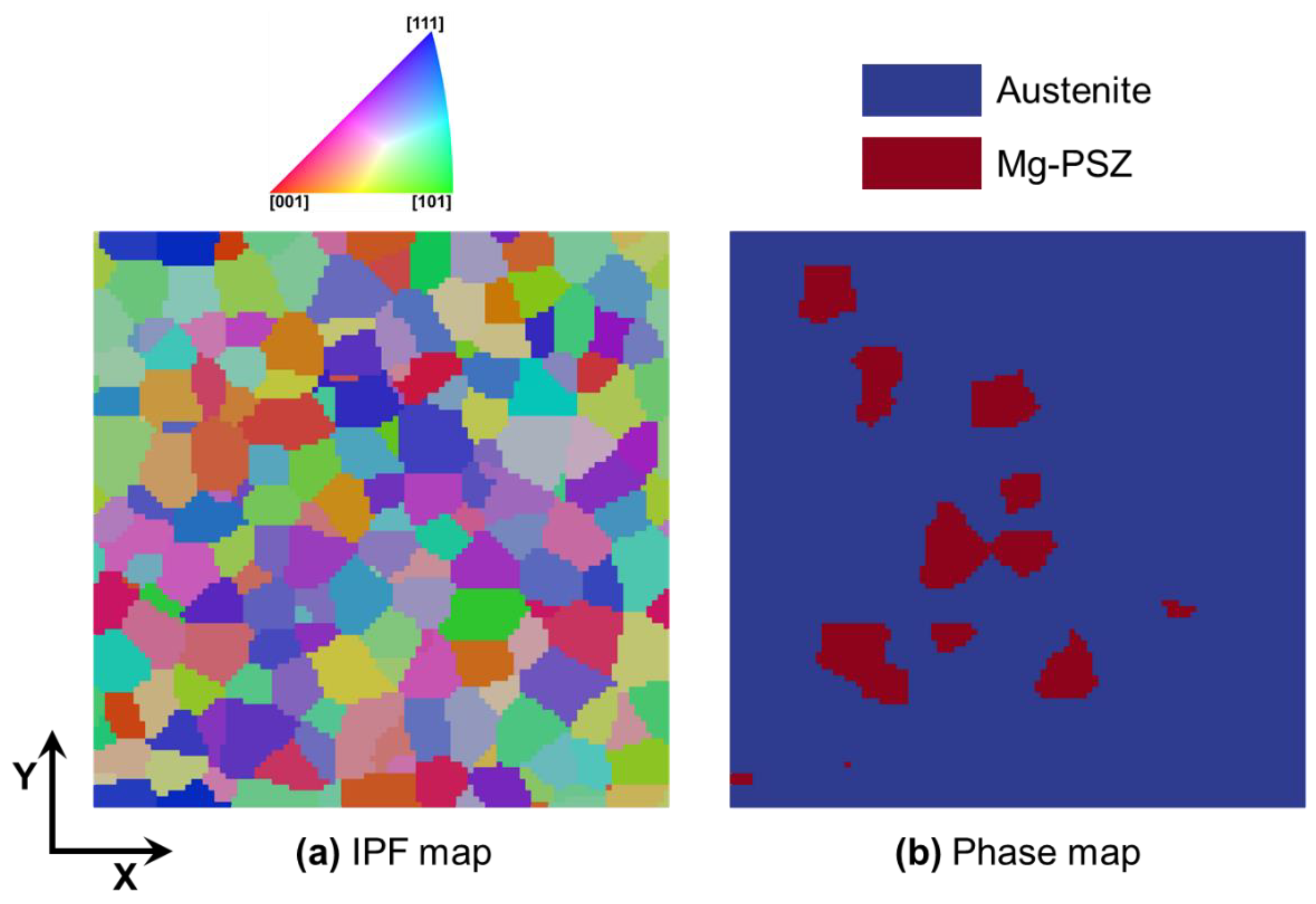
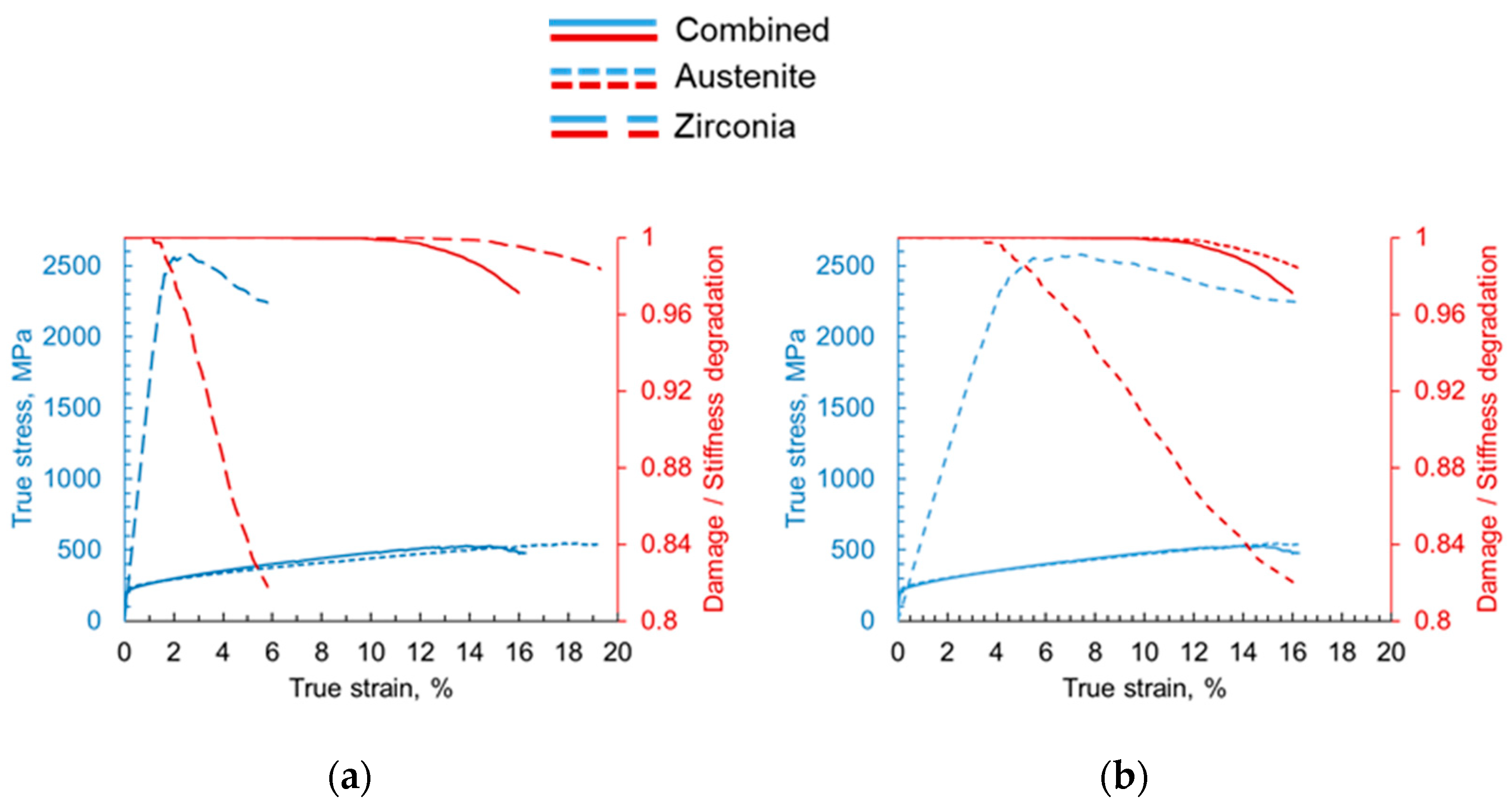


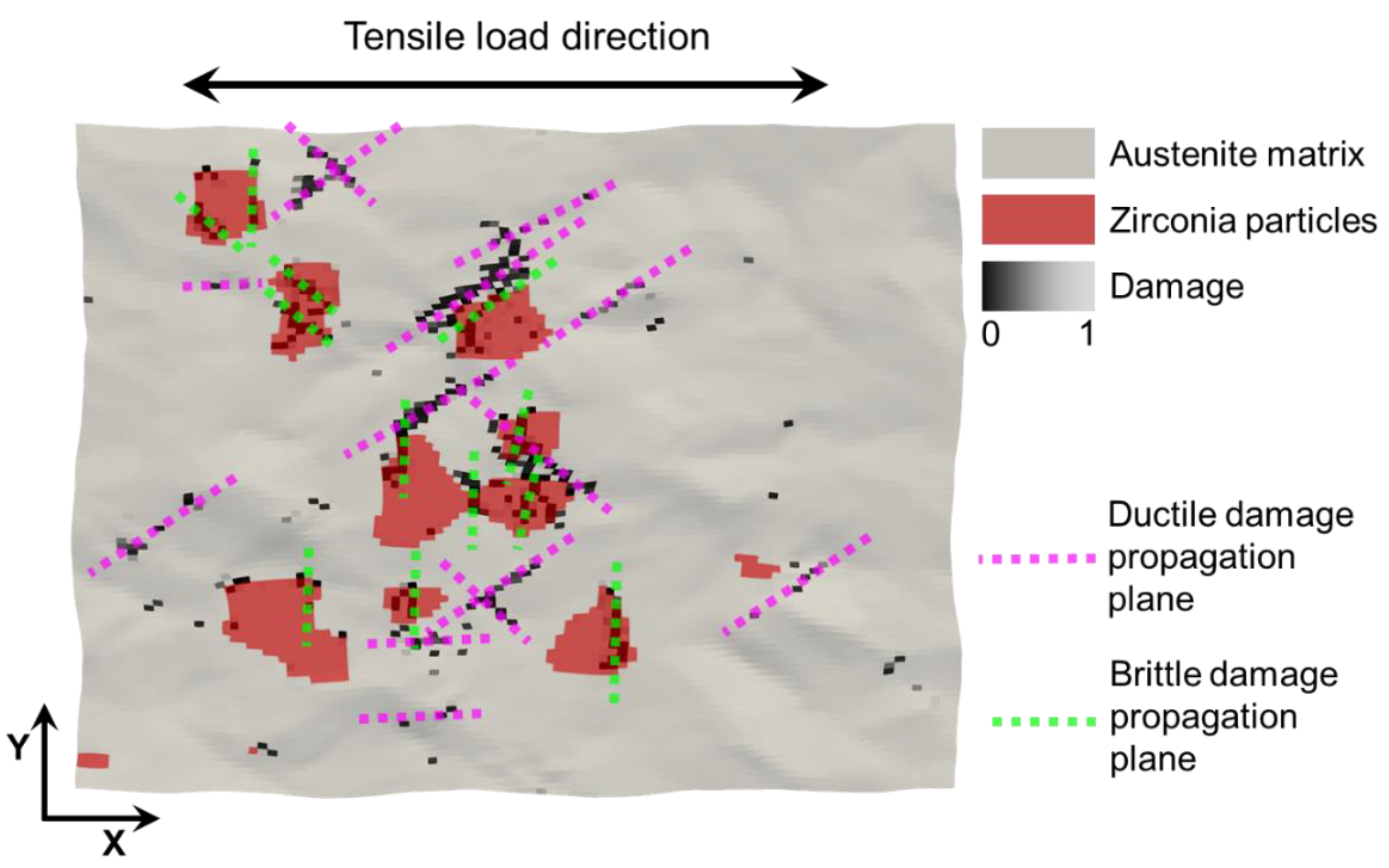
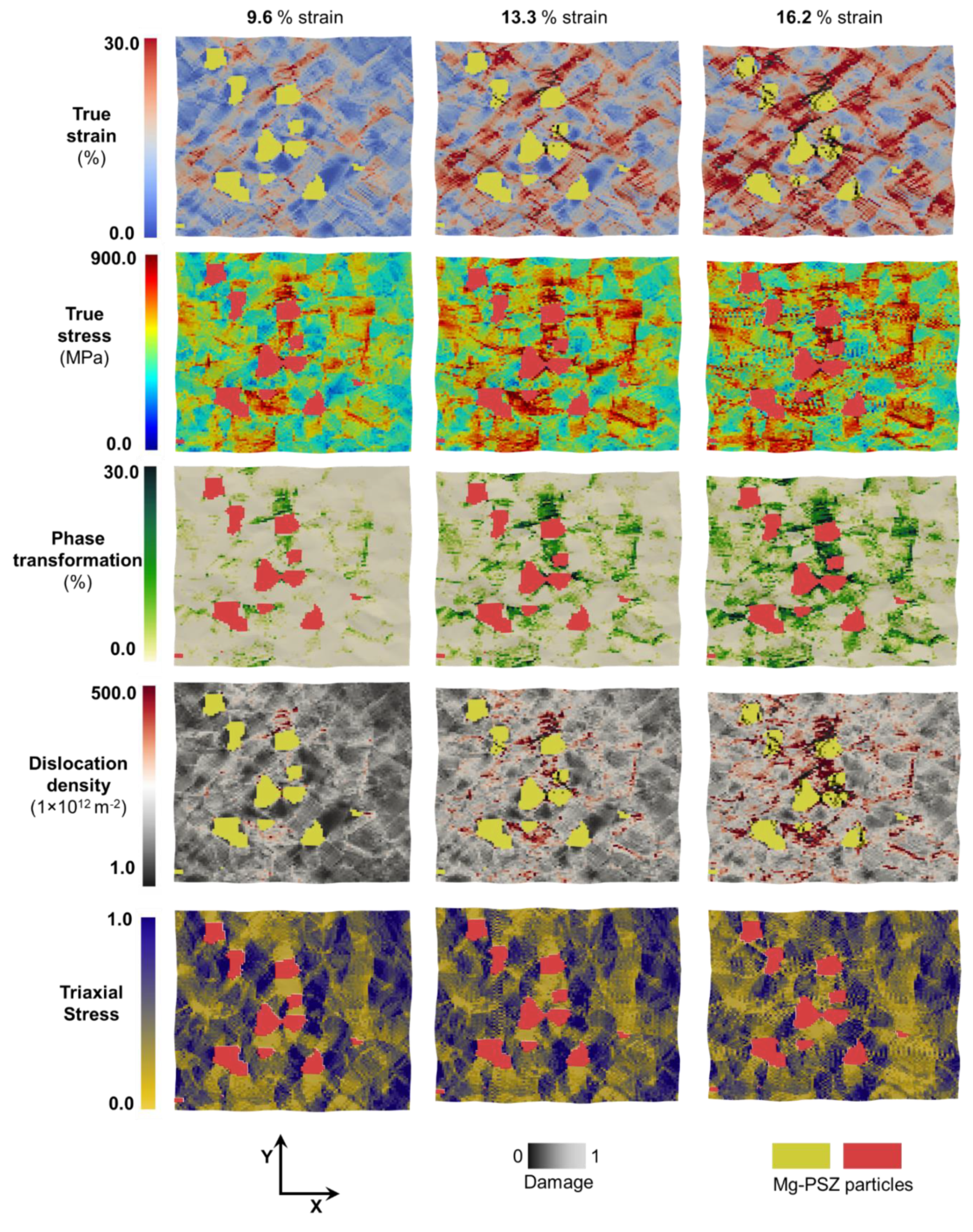
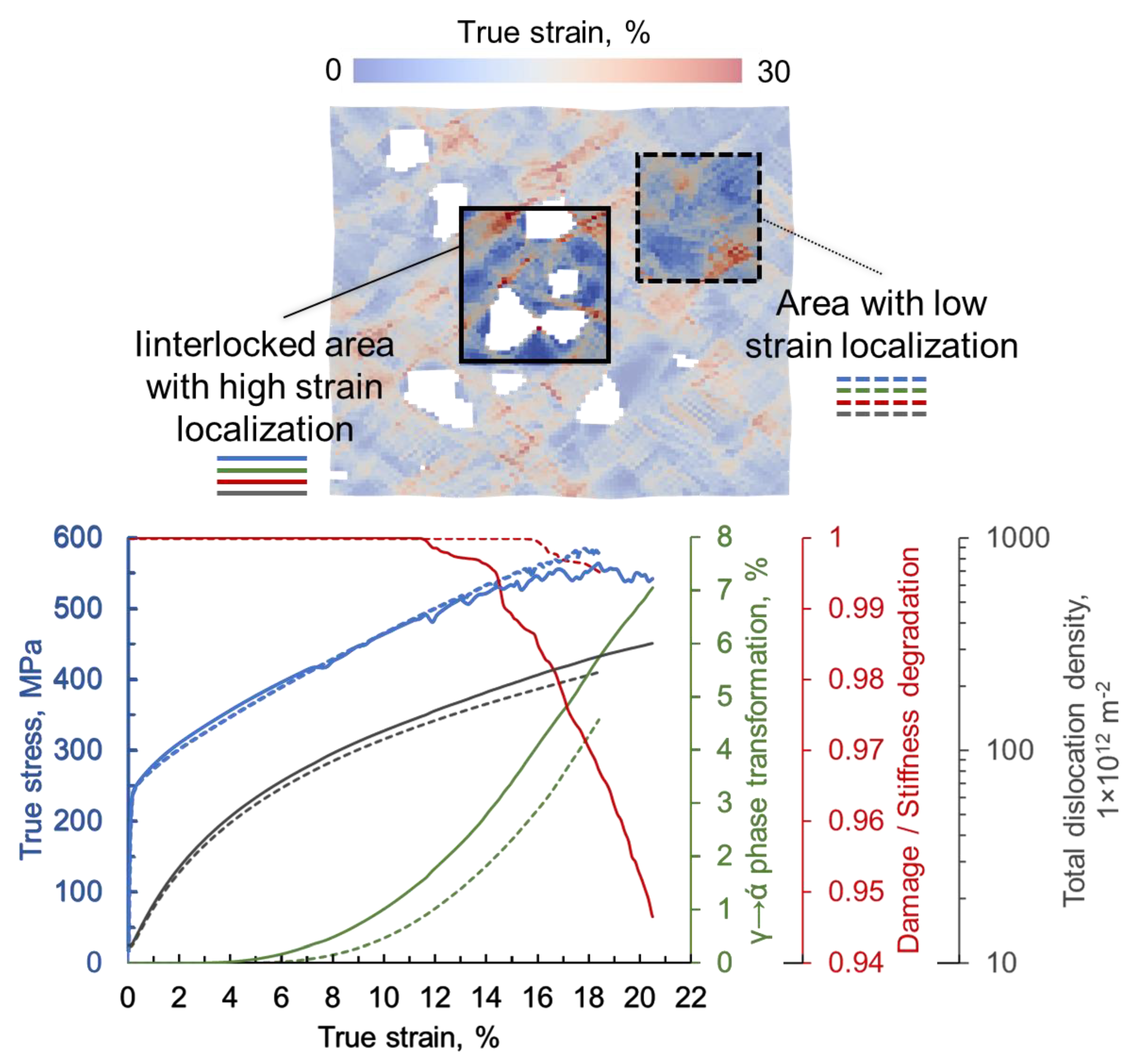
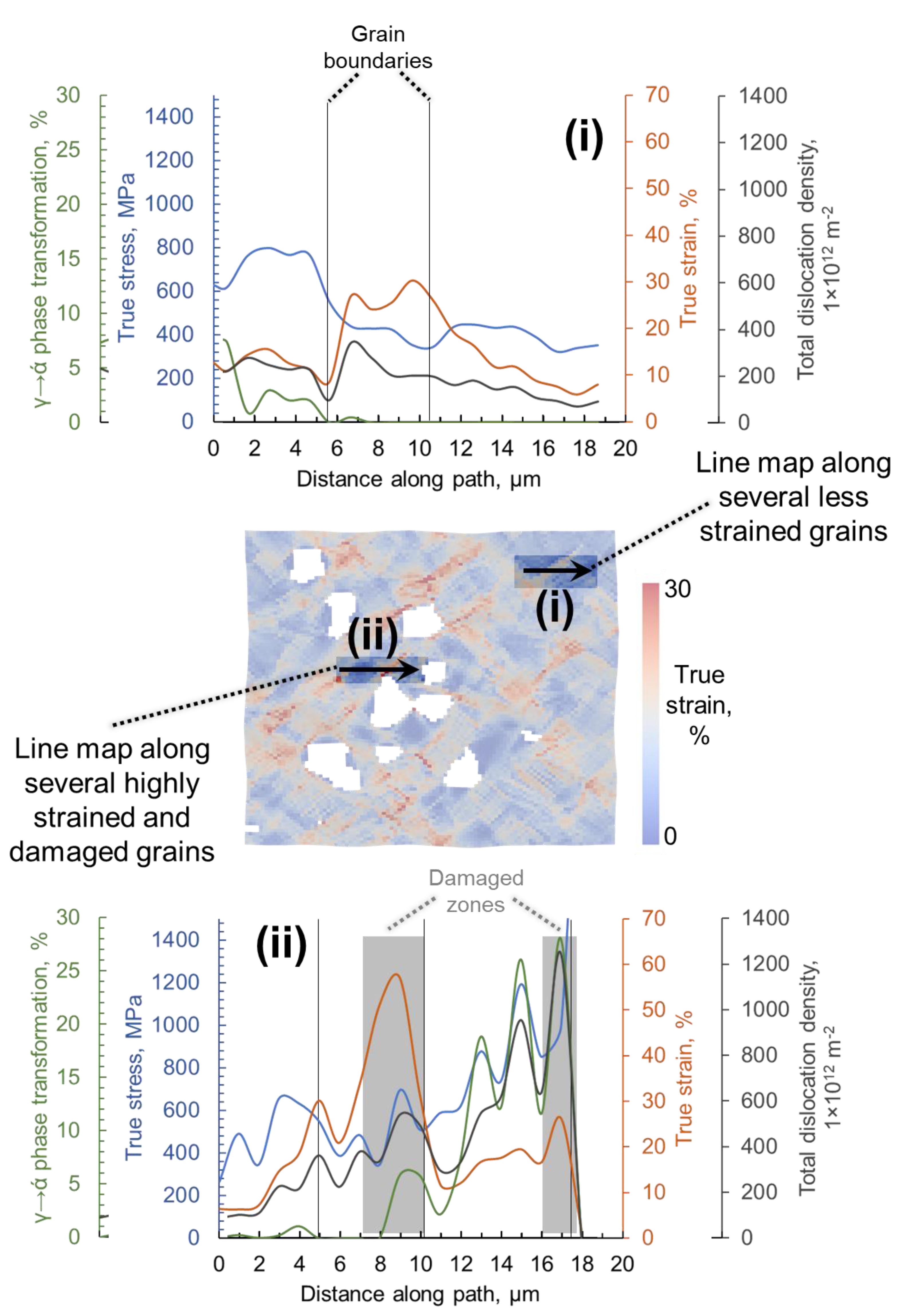
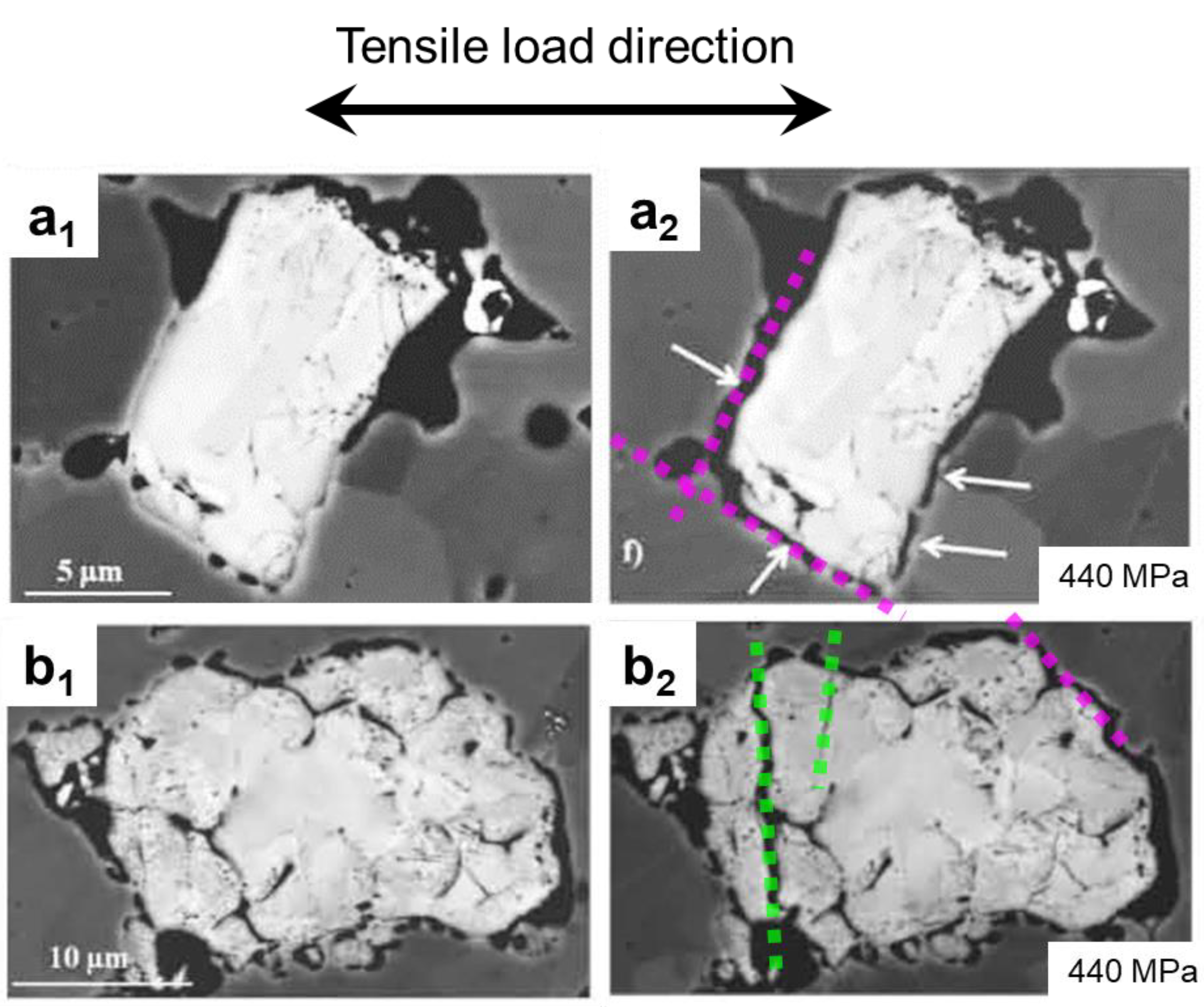
| Symbol | Description | Value | Unit | ||
|---|---|---|---|---|---|
| Martensite Transformation Parameters | Cthreshhold-trans. | Adj. parameter controlling trans threshold stress | 0.5 | -- | |
| Ltr | Width of martensite lath during nucleation | 5.0 × 10−8 | m | ||
| ttr | Average martensite thickness | 5.0 × 10−6 | m | [47] | |
| ß | ß-exponent in transformation formation probability | 3.0 | -- | ||
| CMFP-trans. | Adj. parameter controlling trans mean free path | 10 | -- | ||
| Twinning FormationParameters | r-exponent in twin formation probability | 1.0 | -- | ||
| CMFP-TWIN. | Adj. parameter controlling twin mean free path | 5.0 | -- | ||
| Cthreshhold-TWIN. | Adj. parameter controlling twin threshold stress | 1.3 | -- | ||
| Stacking fault energy | 10 | mJ/m² | [48] | ||
| Change in Gibbs free energy | −2.54 × 107 | J/m3 | [49] | ||
| Dislocation Glide Parameters | Solid solution strength | 5 × 107 | Pa | ||
| Initial dislocation density | 1.0 × 1012 | m−2 | [26] | ||
| Adj. parameter controlling dislocation mean free path | 55 | -- | |||
| Avg. grain size | 50 × 10−6 | m | [50] |
| Austenite [26] | Martensite [51] | Zirconia [41] | Units |
|---|---|---|---|
| C11 = 175.0 | C11 = 242.3 | C11 = 191.0 | GPa |
| C12 = 115.0 | C12 = 117.7 | C12 = 80.0 | GPa |
| C44 = 135.0 | C13 = 45.0 | C44 = 40.0 | GPa |
| C33 = 315.0 | GPa | ||
| C44 = 40.5 | GPa |
| Parameter definition | Property | Value | Units |
|---|---|---|---|
| Interface energy | 1.0 | ||
| Characteristic length | 1.0 | ||
| Damage mobility | 0.01 | ||
| Damage diffusion | 1.0 | - | |
| Critical plastic strain | 0.75 | - | |
| Damage rate sensitivity | 35 | - |
Publisher’s Note: MDPI stays neutral with regard to jurisdictional claims in published maps and institutional affiliations. |
© 2021 by the authors. Licensee MDPI, Basel, Switzerland. This article is an open access article distributed under the terms and conditions of the Creative Commons Attribution (CC BY) license (https://creativecommons.org/licenses/by/4.0/).
Share and Cite
Qayyum, F.; Guk, S.; Prahl, U. Studying the Damage Evolution and the Micro-Mechanical Response of X8CrMnNi16-6-6 TRIP Steel Matrix and 10% Zirconia Particle Composite Using a Calibrated Physics and Crystal-Plasticity-Based Numerical Simulation Model. Crystals 2021, 11, 759. https://doi.org/10.3390/cryst11070759
Qayyum F, Guk S, Prahl U. Studying the Damage Evolution and the Micro-Mechanical Response of X8CrMnNi16-6-6 TRIP Steel Matrix and 10% Zirconia Particle Composite Using a Calibrated Physics and Crystal-Plasticity-Based Numerical Simulation Model. Crystals. 2021; 11(7):759. https://doi.org/10.3390/cryst11070759
Chicago/Turabian StyleQayyum, Faisal, Sergey Guk, and Ulrich Prahl. 2021. "Studying the Damage Evolution and the Micro-Mechanical Response of X8CrMnNi16-6-6 TRIP Steel Matrix and 10% Zirconia Particle Composite Using a Calibrated Physics and Crystal-Plasticity-Based Numerical Simulation Model" Crystals 11, no. 7: 759. https://doi.org/10.3390/cryst11070759









